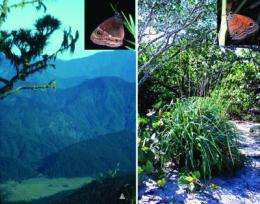Darwin's butterflies? Spectacular species radiation in the Caribbean studied with 'DNA barcoding'

In one of the first taxonomic revisions of Neotropical butterflies that utilizes 'DNA barcoding', Andrei Sourakov (University of Florida, Florida Museum of Natural History) and Evgeny Zakharov (University of Guelph, Canadian Centre for DNA Barcoding at the Biodiversity Institute of Ontario) uncovered a spectacular degree of evolutionary divergence within the satyrine butterfly genus Calisto. The study was published in the open-access journal Comparative Cytogenetics.
The Caribbean has a remarkable diversity of habitats and wildlife. More than 200 species of butterflies belonging to some 100 genera live on the islands, with most genera represented by a single species. Many species are endemic to the region, that is they do not occur anywhere else. This distinctive fauna apparently arose as a result of species immigrating from the mainland at some point during the islands' history, and later evolving mostly into island isolates.
The satyrine butterfly genus Calisto is the most notable of them, because it has the largest number of extant species compared to other butterfly genera found in the region. Until the present revision, Calisto had comprised 54 named taxa, which occupy an extremely diverse array of habitats, suggestive of adaptive radiation on the scale of other classic examples, such as the Galápagos or Darwin's finches.
The authors of the study applied a new set of molecular characters to clarify the classification and evolution of Calisto butterflies. The 'DNA barcoding' technique is based on the analysis of short, standardized gene region within mitochondrial DNA, and provides an efficient method for species identification. As a result, Calisto now contains 34 species and 17 subspecies and new data shed light on the general evolutionary history of the genus.
The discovered spectacular degree of DNA divergence suggests a diversification period of 4-8 million years. Species of Calisto that occur only in Puerto Rico, Cuba, and Jamaica were found likely to have evolved from various Hispaniolan ancestors. The study found no support for previously advocated theories of evolution through geographic separation events due to plate tectonics. The evolutionary time-frame and the phylogenetic position of non-Hispaniolan taxa suggest that ancient dispersal events from Hispaniola to other islands and adaptive radiation within Hispaniola are likely responsible for the diversification within the genus Calisto.
More information: Sourakov A, Zakharov EV (2011) "Darwin's butterflies"? DNA barcoding and the radiation of the endemic Caribbean butterfly genus Calisto (Lepidoptera, Nymphalidae, Satyrinae). Comparative Cytogenetics 5(3): 191. doi: 10.3897/CompCytogen.v5i3.1730
Provided by Pensoft Publishers

















